5乔姆斯基普遍语法(中语学院:唐启萍)
- 格式:ppt
- 大小:640.50 KB
- 文档页数:65
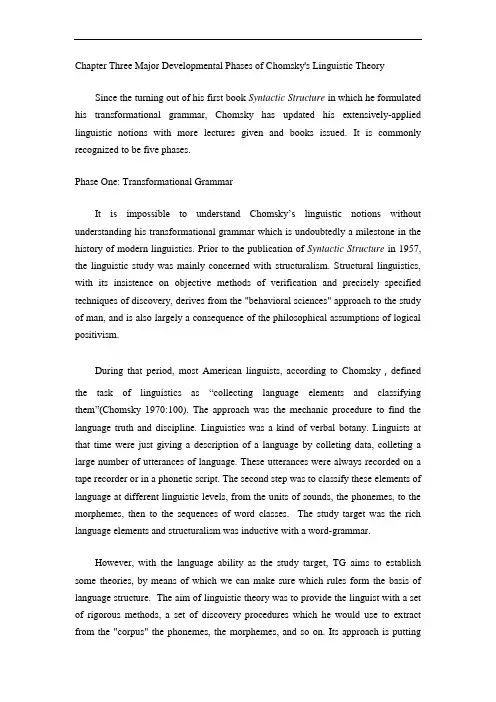
Chapter Three Major Developmental Phases of Chomsky's Linguistic TheorySince the turning out of his first book Syntactic Structure in which he formulated his transformational grammar, Chomsky has updated his extensively-applied linguistic notions with more lectures given and books issued. It is commonly recognized to be five phases.Phase One: Transformational GrammarIt is impossible to understand Chomsky’s linguistic notions without understanding his transformational grammar which is undoubtedly a milestone in the history of modern linguistics. Prior to the publication of Syntactic Structure in 1957, the linguistic study was mainly concerned with structuralism. Structural linguistics, with its insistence on objective methods of verification and precisely specified techniques of discovery, derives from the "behavioral sciences" approach to the study of man, and is also largely a consequence of the philosophical assumptions of logical positivism.During that period, most American linguists, according to Chomsky,defined the task of linguistics as “collecting language elements and classifying them”(Chomsky 1970:100). The approach was the mechanic procedure to find the language truth and discipline. Linguistics was a kind of verbal botany. Linguists at that time were just giving a description of a language by colleting data, colleting a large number of utterances of language. These utterances were always recorded on a tape recorder or in a phonetic script. The second step was to classify these elements of language at different linguistic levels, from the units of sounds, the phonemes, to the morphemes, then to the sequences of word classes. The study target was the rich language elements and structuralism was inductive with a word-grammar.However, with the language ability as the study target, TG aims to establish some theories, by means of which we can make sure which rules form the basis of language structure. The aim of linguistic theory was to provide the linguist with a set of rigorous methods, a set of discovery procedures which he would use to extract from the "corpus" the phonemes, the morphemes, and so on. Its approach is puttingforward hypothesis which is to be tested by native language speakers. Therefore, TG is a deductive language-category grammar which can explain infinite sentences with limited analyses.John R. Searle concludes that:Chomsky argued that since any language contains an infinite number of sentences, any "corpus," even if it contained as many sentences as there are in all the books of the Library of Congress, would still be trivially small. Instead of the appropriate subject matter of linguistics being a randomly or arbitrarily selected set of sentences, the proper object of study was the speaker's underlying knowledge of the language, his "linguistic competence" that enables him to produce and understand sentences he has never heard before.(Searle 1972: 29)Once the conception of the "corpus" as the subject matter is rejected, then the notion of mechanical procedures for discovering linguistic truths goes as well. Chomsky argues that no science has a mechanical procedure for discovering the truth anyway. Rather, what happens is that the scientist formulates hypotheses and tests them against evidence. Linguistics is no different: the linguist makes conjectures about linguistic facts and tests them against the evidence provided by native speakers of the language. He has in short a procedure for evaluating rival hypotheses, but no procedure for discovering true theories by mechanically processing evidence.The Transformational Grammar can be expressed in the following way:1 .Two levels of representation of the structure of sentences: an underlying, more abstract form, termed 'deep structure', and the actual form of the sentence produced, called 'surface structure'. Deep structure is represented in the form of a hierarchical tree diagram, or "phrase structure tree," depicting the abstract grammatical relationships between the words and phrases within a sentence.2. A system of formal rules specifying how deep structures are to be transformed into surface structures.Like a revolution, the transformational grammar established the basis for other subsequent theories of human grammatical knowledge. Since Chomsky's original presentation, many different theories have emerged. With the notion of a transformation remaining a central element in most models, concepts like deep structure and surface structure, phrase structure tree, phrase structure rules, verb phrase, noun phrase, creativity/ productivity became the grammatical elements in language study.Phase Two: Language Competence and Performance; Standard TheoryIn Aspects of the Theory of Syntax in 1965, Chomsky put forward two sets of concepts, which are now widely known. One is competence and performance and the other deep structure and surface structure. Chomsky defines competence as the ideal user's knowledge of the rules of his or her language, and performance the actual realization of this knowledge in linguistic communication.According to Chomsky,speakers have internalized a set of rules about their language. This rule system enables them to produce and understand an infinitely large number of sentences and recognize sentences that are ungrammatical and ambiguous. Chomsky holds that linguists should study the ideal speaker's competence, because the speaker's performance is too haphazard to be studied. Thus, the task of the linguists is to discover the speaker's internalized rules. Competence is independent from performance. The difference between them is like that between knowledge of language and use of that language. Although the investigation of competence is challenging because of the complexity of our knowledge of language, performance is observable. From this point, Chomsky began to look at language from a psychological point of view and consider linguistic competence as a property of the mind of a speaker.In order to explain the difference between "performance" (all sentences that an individual will ever use) and "competence" (all sentences that an individual can utter,but will not necessarily utter), Chomsky emphasizes the existence of some innate knowledge. Chomsky proves that the grammar of a natural language cannot be reduced to a finite-state automaton. He then argues for the existence of two levels of language: an underlying deep structure, which accounts for the fundamental syntactic relationships among language components, and a surface structure, which accounts for the sentences that are actually uttered, and which is generated by transformations of elements in the deep structure. Transformational analysis does overcome the limitations of phrase structure.Chomsky divides the knowledge of language into two components: a universal grammar, which is the knowledge of language possessed by every human, and a set of parameter values and a lexicon, which together constitute the knowledge of a particular language. On the whole, the various components of the grammar as articulated in Chomsky's Aspects of the Theory of Syntax (1965) are: the base component, transformational rules, the lexicon (the set of lexical items with syntactic, semantic, and phonological information), semantic interpretation rules, and the phonological component. Then comes the other distinctive feature of the second phase is the establishment of the Standard Theory, which defines a grammar as made of a syntactic component (phrase structure rules, lexicon and transformational component), a semantic component and a phonological component. The deep structure of a sentence is a tree (the phrase marker) that contains all the words that will appear in its surface structure.By including an account of the relation between sound and meaning in the construction of a grammar, Chomsky started coupling syntax and semantics. In this sense the "standard theory" syntax provides the mechanisms for transforming a meaning (a deep structure) into a phonetic representation (a surface structure).Phase Three: Extended Standard TheoryIn early transformational generative grammar, it was assumed that all semantic interpretation would be done off deep structure, but with the proposals for the extended standard theory (EST) of Chomsky came the realization that certain aspects of semantic interpretation, such as focus and presupposition and scope of quantifiers,must be done off surface structure. More recent developments suggest that EST did not go far enough. In Reflections on Language 1975, Chomsky made a good non-technical review of the EST and various philosophical issues related to generative grammar.In fact, the label 'Extended Standard Theory' was used for a while during the 1970's to describe a particular stage in the evolution of the framework. Over the next 15 years, the framework experienced great revision and changes.Phase Four: REST, GBBy the early 1980's a framework of syntactic theory had been developed, which became different enough to require a completely new presentation and a distinctive period.In 1980 Chomsky delivered a series of lectures at Pisa which were published in the subsequent year under the title 'Lectures on Government and Binding'. These lectures essentially presented the new framework for the first time in an organized, relatively coherent form. As a result, the title of the book was very swiftly given to the framework, which consequently is referred to by many as 'Government & Binding' or 'GB'. GB theory develops directly and without a radical break from earlier work in transformational generative grammar, in particular, from research that falls within the framework of the Extended Standard Theory.Government theory deals with the relationship between a syntactic head (e.g., a verb or preposition) and its dependents and binding theory, the relations among anaphors, pronominals, referring expressions, and their possible antecedents in sentences. 'Government & Binding' has been taken for the label 'Revised, Extended Standard Theory', often abbreviated 'REST'. Chomsky (1985) published Knowledge of Language: Its Nature, Origin and Use, in which the concepts of principles and parameters approach, typically abbreviated `P&P' or `PPA', took the place of former rules.The principle advantage of the Principle and Parameters framework lies in its potential for solving "Plato's Problem": how children can acquire their first language with such remarkable speed and efficiency. The principles do not generalize but the approach might be suggestive both in its achievements and apparent boundaries. Along with developments in other fields, especially immunology, it is regarded as a task of selection rather than that of instruction. The idea can be expressed like: everything is already laid out in the child's mind and the acquisition of knowledge lies in selecting particular choices from what has been laid out.Phase Five: Minimalist ProgramIn the 1990s Chomsky formulated a "Minimalist Program" in an attempt to simplify the symbolic representations of the language facility. The MP remains a version of the P&P model and thus enjoys the benefit of reducing the tension between descriptive and explanatory adequacy. Specific rules and constructions were being abstracted and subsumed under parameterised principles, which were then attributed to the initial state of the language faculty. In general, there are two aspects of this program: first, the minimisation of linguistic levels; second, the economy principles of derivation and representation.Although Chomsky's core ideas and their psychological implications have already formed during the first half of the 20th century, he never stops his revision of his own inventions. Minimalism is a manifestation of Chomsky's intellectual vigor in revision and regarded as the most radical of the periodic upheavals in his thinking.Although this paper have divided the development of Chomsky's language notions into the above five phases, it is no doubt that he has never stopped his devotion to language study and we also see the Post-Chomsky Linguistics which included three major tendencies. The first tendency is generative semantics, which motivates syntactic rules by means of semantic evidence. The second one is the upholding of the viewpoint like "Deep structures are universal" and "All languages have the same deep structure."A third tendency is the constantly increasing employment of the conceptual and terminological apparatus of modern formal logic and formal semantics.Chomsky Noam. Knowledge of Language: Its Nature, Origin, and Use. Westport: Greenwood Publishing Group, 1985.Searle John. Chomsky's Revolution in Linguistics. The New York Review of Books, 1972.Chomsky Noam, Syntactic Structure . Paris: Mouton & Co. N.V., Publishers, 1970.Chomsky Noam. Aspects of the Theory of Syntax. Massachusetts: The M.I.T. Press, 1965.。
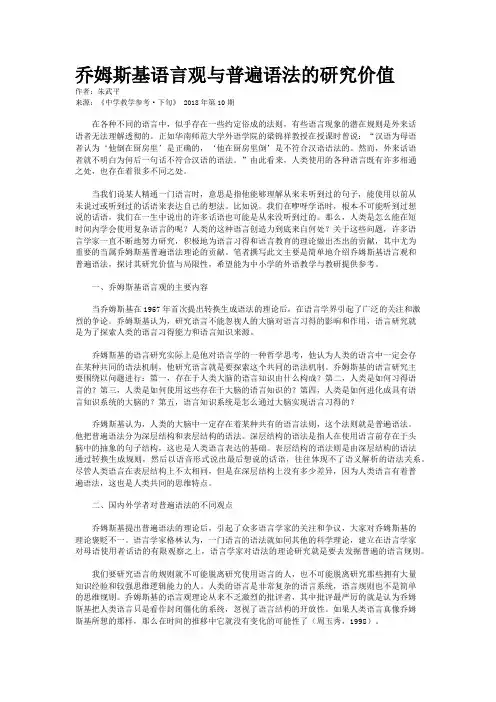
乔姆斯基语言观与普遍语法的研究价值作者:朱武平来源:《中学教学参考·下旬》 2018年第10期在各种不同的语言中,似乎存在一些约定俗成的法则,有些语言现象的潜在规则是外来话语者无法理解透彻的。
正如华南师范大学外语学院的梁锦祥教授在授课时曾说:“汉语为母语者认为‘他倒在厨房里’是正确的,‘他在厨房里倒’是不符合汉语语法的。
然而,外来话语者就不明白为何后一句话不符合汉语的语法。
”由此看来,人类使用的各种语言既有许多相通之处,也存在着很多不同之处。
当我们说某人精通一门语言时,意思是指他能够理解从来未听到过的句子,能使用以前从未说过或听到过的话语来表达自己的想法。
比如说,我们在咿呀学语时,根本不可能听到过想说的话语,我们在一生中说出的许多话语也可能是从来没听到过的。
那么,人类是怎么能在短时间内学会使用复杂语言的呢?人类的这种语言创造力到底来自何处?关于这些问题,许多语言学家一直不断地努力研究,积极地为语言习得和语言教育的理论做出杰出的贡献,其中尤为重要的当属乔姆斯基普遍语法理论的贡献。
笔者撰写此文主要是简单地介绍乔姆斯基语言观和普遍语法,探讨其研究价值与局限性,希望能为中小学的外语教学与教研提供参考。
一、乔姆斯基语言观的主要内容当乔姆斯基在1957年首次提出转换生成语法的理论后,在语言学界引起了广泛的关注和激烈的争论。
乔姆斯基认为,研究语言不能忽视人的大脑对语言习得的影响和作用,语言研究就是为了探索人类的语言习得能力和语言知识来源。
乔姆斯基的语言研究实际上是他对语言学的一种哲学思考,他认为人类的语言中一定会存在某种共同的语法机制,他研究语言就是要探索这个共同的语法机制。
乔姆斯基的语言研究主要围绕以问题进行:第一,存在于人类大脑的语言知识由什么构成?第二,人类是如何习得语言的?第三,人类是如何使用这些存在于大脑的语言知识的?第四,人类是如何进化成具有语言知识系统的大脑的?第五,语言知识系统是怎么通过大脑实现语言习得的?乔姆斯基认为,人类的大脑中一定存在着某种共有的语言法则,这个法则就是普遍语法。
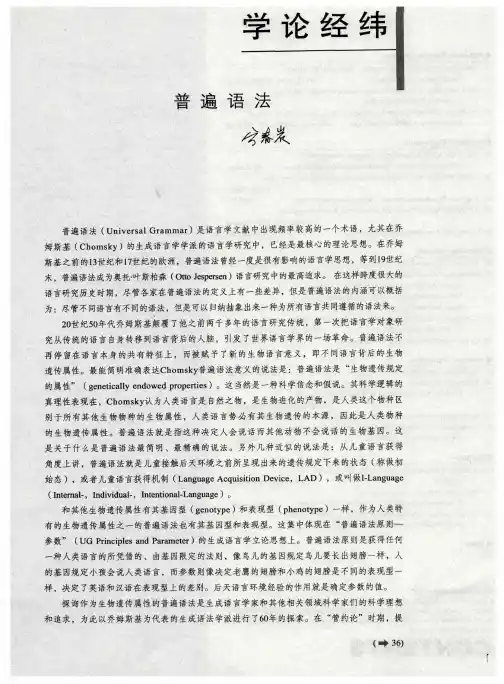
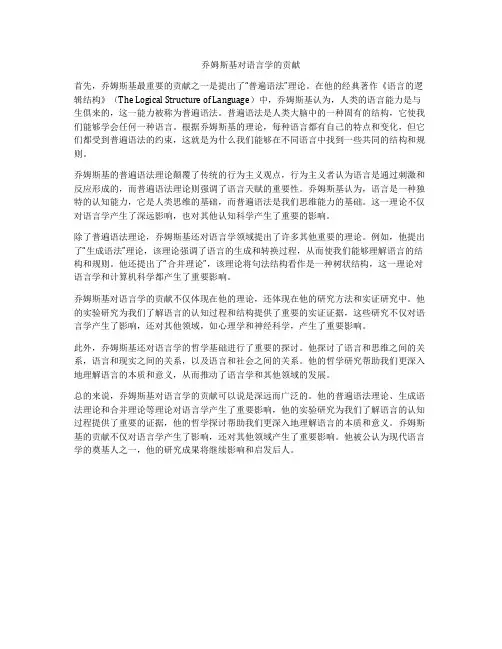
乔姆斯基对语言学的贡献首先,乔姆斯基最重要的贡献之一是提出了“普遍语法”理论。
在他的经典著作《语言的逻辑结构》(The Logical Structure of Language)中,乔姆斯基认为,人类的语言能力是与生俱来的,这一能力被称为普遍语法。
普遍语法是人类大脑中的一种固有的结构,它使我们能够学会任何一种语言。
根据乔姆斯基的理论,每种语言都有自己的特点和变化,但它们都受到普遍语法的约束,这就是为什么我们能够在不同语言中找到一些共同的结构和规则。
乔姆斯基的普遍语法理论颠覆了传统的行为主义观点,行为主义者认为语言是通过刺激和反应形成的,而普遍语法理论则强调了语言天赋的重要性。
乔姆斯基认为,语言是一种独特的认知能力,它是人类思维的基础,而普遍语法是我们思维能力的基础。
这一理论不仅对语言学产生了深远影响,也对其他认知科学产生了重要的影响。
除了普遍语法理论,乔姆斯基还对语言学领域提出了许多其他重要的理论。
例如,他提出了“生成语法”理论,该理论强调了语言的生成和转换过程,从而使我们能够理解语言的结构和规则。
他还提出了“合并理论”,该理论将句法结构看作是一种树状结构,这一理论对语言学和计算机科学都产生了重要影响。
乔姆斯基对语言学的贡献不仅体现在他的理论,还体现在他的研究方法和实证研究中。
他的实验研究为我们了解语言的认知过程和结构提供了重要的实证证据,这些研究不仅对语言学产生了影响,还对其他领域,如心理学和神经科学,产生了重要影响。
此外,乔姆斯基还对语言学的哲学基础进行了重要的探讨。
他探讨了语言和思维之间的关系,语言和现实之间的关系,以及语言和社会之间的关系。
他的哲学研究帮助我们更深入地理解语言的本质和意义,从而推动了语言学和其他领域的发展。
总的来说,乔姆斯基对语言学的贡献可以说是深远而广泛的。
他的普遍语法理论、生成语法理论和合并理论等理论对语言学产生了重要影响,他的实验研究为我们了解语言的认知过程提供了重要的证据,他的哲学探讨帮助我们更深入地理解语言的本质和意义。
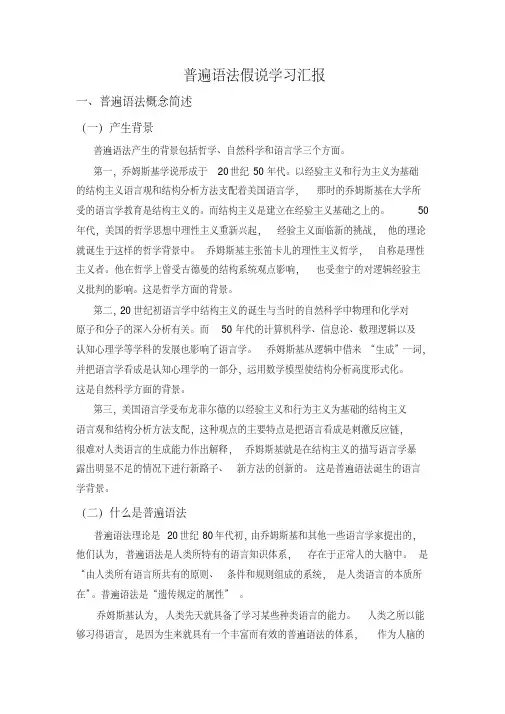
普遍语法假说学习汇报一、普遍语法概念简述(一)产生背景普遍语法产生的背景包括哲学、自然科学和语言学三个方面。
第一,乔姆斯基学说形成于20世纪50年代。
以经验主义和行为主义为基础的结构主义语言观和结构分析方法支配着美国语言学,那时的乔姆斯基在大学所受的语言学教育是结构主义的。
而结构主义是建立在经验主义基础之上的。
50年代,美国的哲学思想中理性主义重新兴起,经验主义面临新的挑战,他的理论就诞生于这样的哲学背景中。
乔姆斯基主张笛卡儿的理性主义哲学,自称是理性主义者。
他在哲学上曾受古德曼的结构系统观点影响,也受奎宁的对逻辑经验主义批判的影响。
这是哲学方面的背景。
第二,20世纪初语言学中结构主义的诞生与当时的自然科学中物理和化学对原子和分子的深入分析有关。
而50年代的计算机科学、信息论、数理逻辑以及认知心理学等学科的发展也影响了语言学。
乔姆斯基从逻辑中借来“生成”一词,并把语言学看成是认知心理学的一部分,运用数学模型使结构分析高度形式化。
这是自然科学方面的背景。
第三,美国语言学受布龙菲尔德的以经验主义和行为主义为基础的结构主义语言观和结构分析方法支配,这种观点的主要特点是把语言看成是刺激反应链,很难对人类语言的生成能力作出解释,乔姆斯基就是在结构主义的描写语言学暴露出明显不足的情况下进行新路子、新方法的创新的。
这是普遍语法诞生的语言学背景。
(二)什么是普遍语法普遍语法理论是20世纪80年代初,由乔姆斯基和其他一些语言学家提出的,他们认为,普遍语法是人类所特有的语言知识体系,存在于正常人的大脑中。
是“由人类所有语言所共有的原则、条件和规则组成的系统,是人类语言的本质所在”。
普遍语法是“遗传规定的属性”。
乔姆斯基认为,人类先天就具备了学习某些种类语言的能力。
人类之所以能够习得语言,是因为生来就具有一个丰富而有效的普遍语法的体系,作为人脑的。
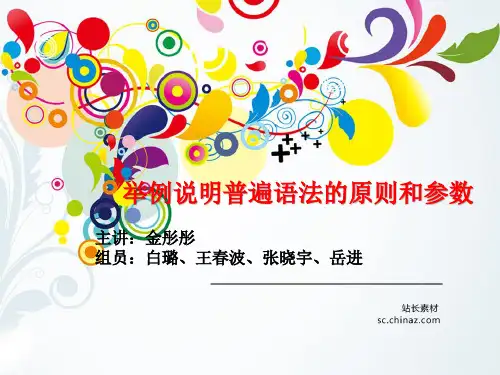
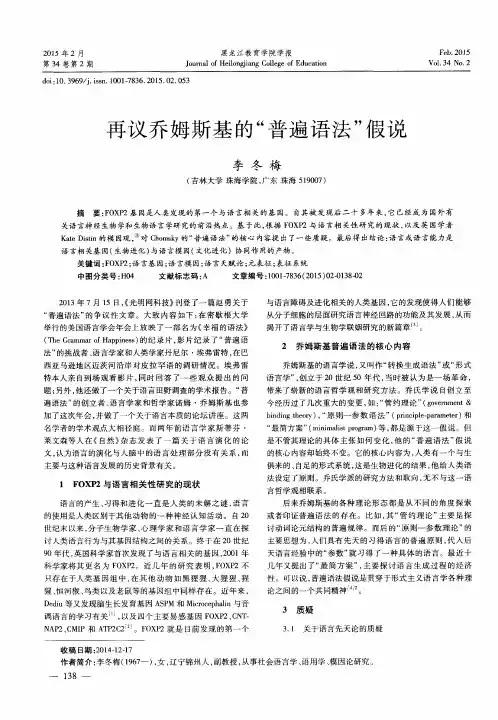
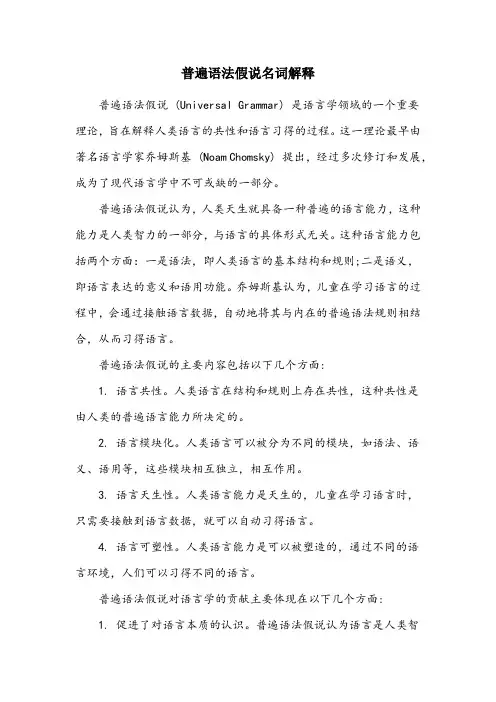
普遍语法假说名词解释普遍语法假说 (Universal Grammar) 是语言学领域的一个重要理论,旨在解释人类语言的共性和语言习得的过程。
这一理论最早由著名语言学家乔姆斯基 (Noam Chomsky) 提出,经过多次修订和发展,成为了现代语言学中不可或缺的一部分。
普遍语法假说认为,人类天生就具备一种普遍的语言能力,这种能力是人类智力的一部分,与语言的具体形式无关。
这种语言能力包括两个方面:一是语法,即人类语言的基本结构和规则;二是语义,即语言表达的意义和语用功能。
乔姆斯基认为,儿童在学习语言的过程中,会通过接触语言数据,自动地将其与内在的普遍语法规则相结合,从而习得语言。
普遍语法假说的主要内容包括以下几个方面:1. 语言共性。
人类语言在结构和规则上存在共性,这种共性是由人类的普遍语言能力所决定的。
2. 语言模块化。
人类语言可以被分为不同的模块,如语法、语义、语用等,这些模块相互独立,相互作用。
3. 语言天生性。
人类语言能力是天生的,儿童在学习语言时,只需要接触到语言数据,就可以自动习得语言。
4. 语言可塑性。
人类语言能力是可以被塑造的,通过不同的语言环境,人们可以习得不同的语言。
普遍语法假说对语言学的贡献主要体现在以下几个方面:1. 促进了对语言本质的认识。
普遍语法假说认为语言是人类智力的一部分,与语言的具体形式无关,这一观点促进了对语言本质的深入认识。
2. 解释了语言习得的过程。
普遍语法假说认为儿童在学习语言时,会通过接触语言数据,自动地将其与内在的普遍语法规则相结合,从而习得语言,这一观点解释了语言习得的过程。
3. 促进了对语言结构的研究。
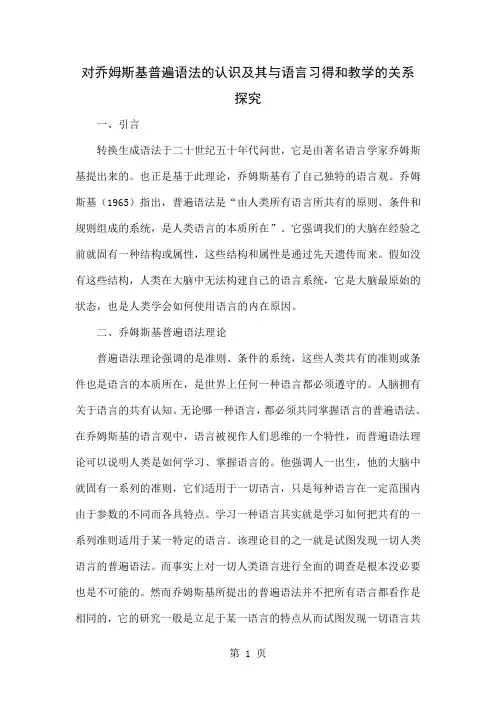
对乔姆斯基普遍语法的认识及其与语言习得和教学的关系探究一、引言转换生成语法于二十世纪五十年代问世,它是由著名语言学家乔姆斯基提出来的。
也正是基于此理论,乔姆斯基有了自己独特的语言观。
乔姆斯基(1965)指出,普遍语法是“由人类所有语言所共有的原则、条件和规则组成的系统,是人类语言的本质所在”。
它强调我们的大脑在经验之前就固有一种结构或属性,这些结构和属性是通过先天遗传而来。
假如没有这些结构,人类在大脑中无法构建自己的语言系统,它是大脑最原始的状态,也是人类学会如何使用语言的内在原因。
二、乔姆斯基普遍语法理论普遍语法理论强调的是准则、条件的系统,这些人类共有的准则或条件也是语言的本质所在,是世界上任何一种语言都必须遵守的。
人脑拥有关于语言的共有认知。
无论哪一种语言,都必须共同掌握语言的普遍语法。
在乔姆斯基的语言观中,语言被视作人们思维的一个特性,而普遍语法理论可以说明人类是如何学习、掌握语言的。
他强调人一出生,他的大脑中就固有一系列的准则,它们适用于一切语言,只是每种语言在一定范围内由于参数的不同而各具特点。
学习一种语言其实就是学习如何把共有的一系列准则适用于某一特定的语言。
该理论目的之一就是试图发现一切人类语言的普遍语法。
而事实上对一切人类语言进行全面的调查是根本没必要也是不可能的。
然而乔姆斯基所提出的普遍语法并不把所有语言都看作是相同的,它的研究一般是立足于某一语言的特点从而试图发现一切语言共有的特点,是一个由个性到共性的过程,进而试图更好地阐释人类所有的语言。
三、普遍语法与第一语言习得乔姆斯基的语言习得理论指出,人脑的原始、最终状态对人类对学习或掌握一门语言具有很大影响。
人脑的原始状态一般是新生儿的大脑,此时它对语言毫无了解,即最初零状态(S0)。
最终状态则是指成人的母语使用状态,即已经完全了解如何使用语言即稳定状态(Ss)。
学习、掌握一种语言其实就是从最初状态向最终状态的一种趋于稳定的动态发展过程,也就是S0→Ss。

乔姆斯基的名词解释当今语言学界中,诺姆·乔姆斯基(Noam Chomsky)被誉为一位杰出的语言学家和认知科学家。
他的研究涵盖了广泛的领域,其中包括语言学、心理学、计算机科学和社会学等。
他提出了一些重要的理论和名词,这对于我们理解语言和思维的本质至关重要。
1.普遍语法(Universal Grammar)乔姆斯基最著名的理论之一是普遍语法。
普遍语法是一种通过探究各种语言的共通性,并试图揭示其底层结构和规则的理论。
乔姆斯基认为,人类天生掌握了一种固有的语言能力,这种能力使他们能够学习和理解任何语言。
普遍语法提供了一个解释这种语言能力的理论框架。
普遍语法的核心概念是“生成语法”,即一套规则和结构,用于构建和理解无限数量的句子。
这些规则可以解释为人们的大脑如何将有限的语言元素组合成无限数量的表达方式。
因此,乔姆斯基认为,虽然不同语言具有各自的特殊性,但它们都遵循着普遍语法所定义的基本原则。
2.语言生成(Language Generation)在乔姆斯基看来,语言生成是一种人类天生具备的能力。
他认为,孩子从小就能产生出正确而合乎语法的句子,这是因为他们内部具有一种语言生成的机制。
这种机制可能是人脑内部的一种基因编程或是认知的一种本能。
通过语言生成,人们能够根据自身的意图和思维,构建出一系列具有合理结构和意义的句子。
这种能力使人类能够参与各种复杂的沟通和思维活动,从而进一步展开知识的积累和交流。
3.生成语义学(Generative Semantics)生成语义学是乔姆斯基的另一项重要贡献。
与传统的语义学不同,生成语义学试图通过研究句子内在的语义结构和信息传递方式,理解语言中的意义和思维过程。
生成语义学认为,句子的意义不仅依赖于单词的字面意义,还受到上下文和语境的影响。
生成语义学的一个重要概念是“深层结构”和“表层结构”。
深层结构指的是句子在思维过程中的原始表示,而表层结构则是这种思维过程经过语法处理后的最终输出。

乔姆斯基的名词解释语言是人类交流的重要工具,而对于语言学这门学科来说,有一位一直被誉为语言学大师的人物,他就是美国语言学家诺姆·乔姆斯基。
乔姆斯基在语言学领域有着深远的影响力,他的理论和观点被广泛应用于各种语言学研究。
本文将为大家解释乔姆斯基的一些重要名词,探讨他对语言学的贡献。
一、生成语法理论(Generative Grammar)生成语法理论是乔姆斯基提出的一种理论框架,用于描述人类语言的结构和生成规则。
根据生成语法理论,人类语言具有一定的普遍性特征和结构,而这些特征可以通过一套简单的生成规则来解释。
生成语法理论通过研究句子的结构和组成成分之间的关系,探寻语言的本质和规律。
二、语言的普遍语法(Universal Grammar)语言的普遍语法是乔姆斯基在生成语法理论基础上提出的概念。
根据乔姆斯基的观点,人类具备一种内在的语言能力,这种能力使得他们能够学习和掌握任何一种语言。
语言的普遍语法是这种内在能力的表现,它是人类语言中共有的语法结构和规则。
乔姆斯基认为,通过研究普遍语法可以更深入地了解人类的语言能力和思维方式。
三、语言的生成(Language Acquisition Device)语言的生成是乔姆斯基提出的概念,指的是人类天生具备的一种心理机制,用于学习和理解语言。
乔姆斯基认为,语言的生成是一种先天的能力,儿童在接触到语言输入时,通过这种机制能够自动地从环境中学习和掌握语言。
生成语言的能力是人类与生俱来的,而具体的语言则通过语言输入来激发和发展。
四、表层结构和深层结构(Surface Structure and Deep Structure)表层结构和深层结构是乔姆斯基在生成语法理论中引入的两个重要概念。
表层结构是句子的表面形式,即句子的语序和词汇组成等。
而深层结构则是句子的内在意义和结构,是生成句子的基本思维过程。
乔姆斯基通过研究表层结构和深层结构之间的关系,揭示了语言的生成规则和句子的解释方式。
乔姆斯基的普遍语法理论保定学院刘丽娟摘要:本文阐述了乔姆斯基的普遍语法理论的产生背景、理论来源和主要内容,并在此基础上从语言习得的角度着重探讨了普遍语法理论的核心思想。
本文从语言习得的定义,引出三种理论布龙菲尔德的行为主义理论,乔姆斯基的天赋假说和交互模式.在探讨过程中,乔姆斯基对其他行为主义的批判.虽然乔姆斯基的天赋假说一直处于不断的调整和更新中,但始终是一种假设性的理论,仍无得到很好的验证.关键词:乔姆斯基,普遍语法,语言习得装置,心理学,语言学,交互主义,行为主义Abstract: with a brief introduction of the theoretical background and content of Chomsky Theory of UG,this dissertation emphatically examines the major assumptions of the theory concerning language acquisition 。
This paper discussing from the definition of LA,lead to the three theories a behaviourist view ,an innatist view ,an interactionist view.It is of epoch-making significance that Chomsky’s critique of other stimulus-reinforcement theory demonstrates a breakthrough against the behaviorist doctrine which has governed American psychology for nearly half a century。
So far,however,the theory of UG is considered were hypothetic assumptions resting on no evidence and exiguously actualspeculation ,though it is still under revision today。
再议乔姆斯基的“普遍语法”假说作者:李冬梅来源:《黑龙江教育学院学报》2015年第02期摘要:FOXP2基因是人类发现的第一个与语言相关的基因。
自其被发现后二十多年来,它已经成为国外有关语言神经生物学和生物语言学研究的前沿热点。
基于此,根据FOXP2与语言相关性研究的现状,以及英国学者Kate Distin的模因观,①对Chomsky的“普遍语法”的核心内容提出了一些质疑。
最后得出结论:语言或语言能力是语言相关基因(生物进化)与语言模因(文化进化)协同作用的产物。
关键词:FOXP2;语言基因;语言模因;语言天赋论;元表征;表征系统中图分类号:H04文献标志码:A文章编号:1001-7836( 2015) 02-0138 -022013年7月15日,《光明网科技》刊登了一篇赵勇关于“普遍语法”的争议性文章。
大致内容如下:在密歇根大学举行的美国语言学会年会上放映了一部名为《幸福的语法》( The Grammar of Happiness)的纪录片,影片纪录了“普遍语法”的挑战者、语言学家和人类学家丹尼尔·埃弗雷特,在巴西亚马逊地区迈茨河沿岸对皮拉罕语的调研情况。
埃弗雷特本人亲自到场观看影片,同时回答了一些观众提出的问题;另外,他还做了一个关于语言田野调查的学术报告。
“普遍语法”的创立者、语言学家和哲学家诺姆·乔姆斯基也参加了这次年会,并做了一个关于语言本质的论坛讲座。
这两名学者的学术观点大相径庭。
而两年前语言学家斯蒂芬·莱文森等人在《自然》杂志发表了一篇关于语言演化的论文,认为语言的演化与人脑中的语言处理部分没有关系,而主要与这种语言发展的历史背景有关。
1 FOXP2与语言相关性研究的现状语言的产生、习得和进化一直是人类的未解之谜,语言的使用是人类区别于其他动物的一种神经认知活动。
自20世纪末以来,分子生物学家、心理学家和语言学家一直在探讨人类语言行为与其基因结构之间的关系。
从二语习得的角度分析乔姆斯基的普遍语法作者:魏晏龙来源:《西部学刊》2022年第01期摘要:乔姆斯基提出的普遍语法被认为是揭示语言学习者如何习得外语的代表性理论之一,但其是否在第二语言习得中起作用至今尚存争议。
普遍语法是作为一套母语习得的理论被广为接受的,但其与二语习得有着密切的关系,在其框架下研究语言习得问题具有一定的优越性。
尽管普遍语法在理论的完整性等方面存在着不足和缺憾,使用范围和研究对象有限,运用到语言教学实践不多,但其不失为一套成熟完整的二语习得理论。
富有成果地将普遍语法运用于外语教学实践之中,能为理论的有效性和可靠性提供更多实验性的证据。
关键词:普遍语法;乔姆斯基;二语习得;参数;先天论中图分类号:H0-06文献标识码:A文章编号:2095-6916(2022)01-0116-05从上世纪六十年代至今,在全世界范围内关于第二语言习得的理论层出不穷,为二语习得及外语教学在实践方面的发展做出了指导性的贡献。
但是应该认识到,并不是在一个研究领域出现的理论越多,这个领域就会越成熟,而当前的二语习得领域就正在面对这样的情况。
诚如应用语言学家斯波尔斯基所言:“在二语习得领域,不断出现的新的理论普遍都无法成功地取代以往的理论,这便出现了新老理论尴尬共存的局面。
”[1]語言学家LONG也指出成功的学科之所以能够成功是因为它们有着“主导的理论(dominant theory)”[2]。
虽然到目前为止还没有哪一种理论能够在流派纷杂的二语习得领域一统天下,但一些理论已经因为有着相对严谨、完备的框架及理论体系而被越来越多的人接受和推崇。
这其中比较有代表性的有克拉申的监察模式(Monitor Model)、舒曼的文化适应理论(Acculturation Theory)以及乔姆斯基①的普遍语法(Universal Grammar,简称UG)。
本文着力分析乔姆斯基的普遍语法及该理论对于中国大学生外语学习的参考价值和实践意义。
时间:2008年11月19日星期三地点:教一107主讲人:Fu xiaoge Chen qian主持人:Huang yan指导老师:锁麟囊观众评分(各类指数均为满分5分):学术指数:4.5分;逻辑指数:4.5分;表达指数:4.5分;魅力指数:4分乔姆斯基语言学第一部分乔姆斯基其人(主讲人:付晓歌)一、生平1928年12月7日生于费城的一个犹太人家庭。
一个人的成才,往往和家庭环境的影响是分不开的,乔姆斯基也不例外。
他的父亲——威廉乔姆斯基——就是一位颇有名望的希伯来语学者。
曾经写过《大卫金西的希伯来语法》。
幼年的乔姆斯基在他父亲的熏陶下,爱上了语言研究工作。
1947年,他认识了美国描写语言学“后布龙菲尔德学派”的代表人物海里斯。
在学习了海里斯《结构语言学方法》一书的内容后,他被海里斯哪种严密的方法深深吸引了,从此,他立志以语言学作为自己的毕生事业,进入海里斯执教的宾夕法尼亚大学,专攻语言学。
在这之后,他试图用结构主义的方法来研究希伯来语,但是收效甚微。
于是他决定适当改变海里斯的方法,建立一种形式学语言理论。
使语法获得一种较强的解释力。
他感到,在结构主义的框架中研究语言,往往会引出错误的结果。
为了完成形式语言理论这一有意义的课题,在海里斯的建议下,乔姆斯基从1953年开始学习哲学逻辑学现代数学学。
在这种多学科知识背景下,他对美国描写语言学的那一套方法越来越不满意,决心与结构主义思想彻底决裂,另起炉灶,走一条自己的语言学道路。
1954年乔姆斯基开始写《语言理论的逻辑结构》(The Logical Structure of Linguistic Theory)一书,乔姆斯基的成名作《句法结构》就是这部著作的缩写本。
在这本书里,初步勾画出生成语法的理论观点和思想方法。
1955年乔姆斯基以《转换分析》一文获得了博士学位。
通年乔姆斯基经哈勒和雅各布逊推荐,在麻省理工学院的现代语言学系任教。
这时候,乔姆斯基的形式语言学理论的思想已经基本成熟,他更加清醒的认识到,结构主义的路子完全是错误的,他开始大胆的向结构主义挑战,但是人微言轻,当时的语言学界并没有对他的言论表现出丝毫的兴趣。